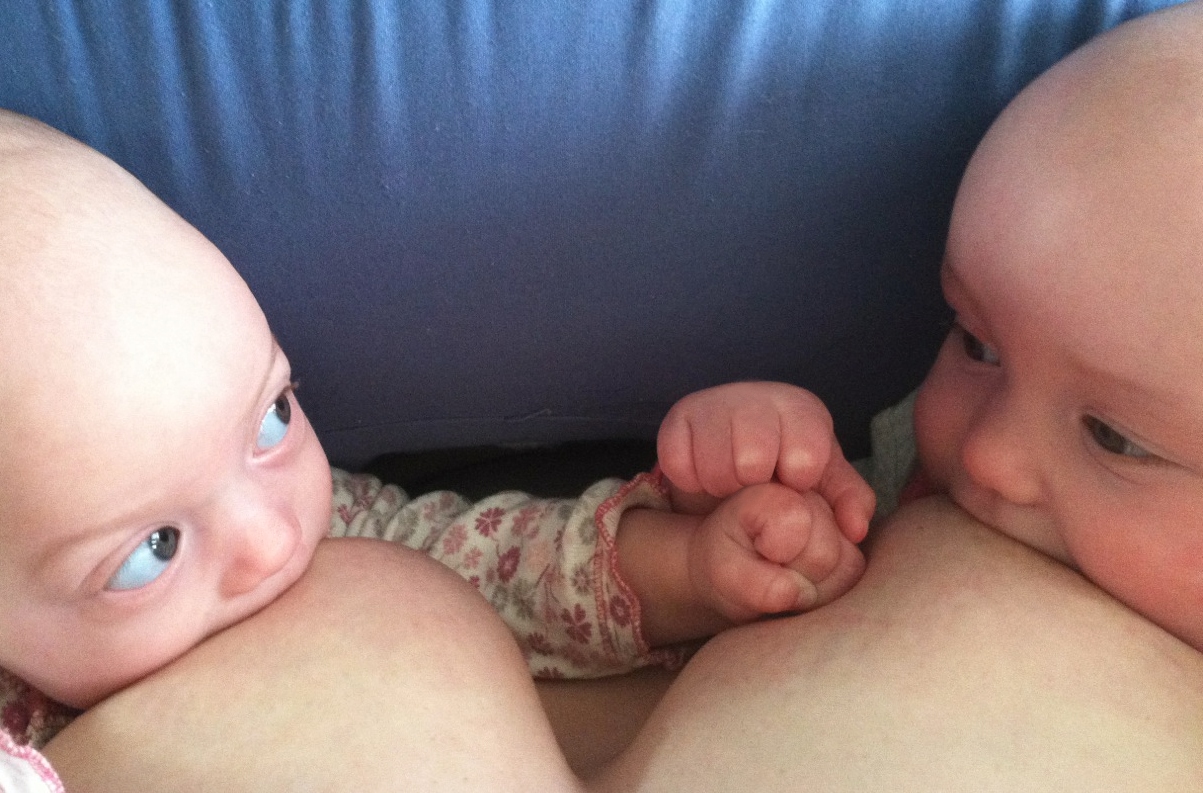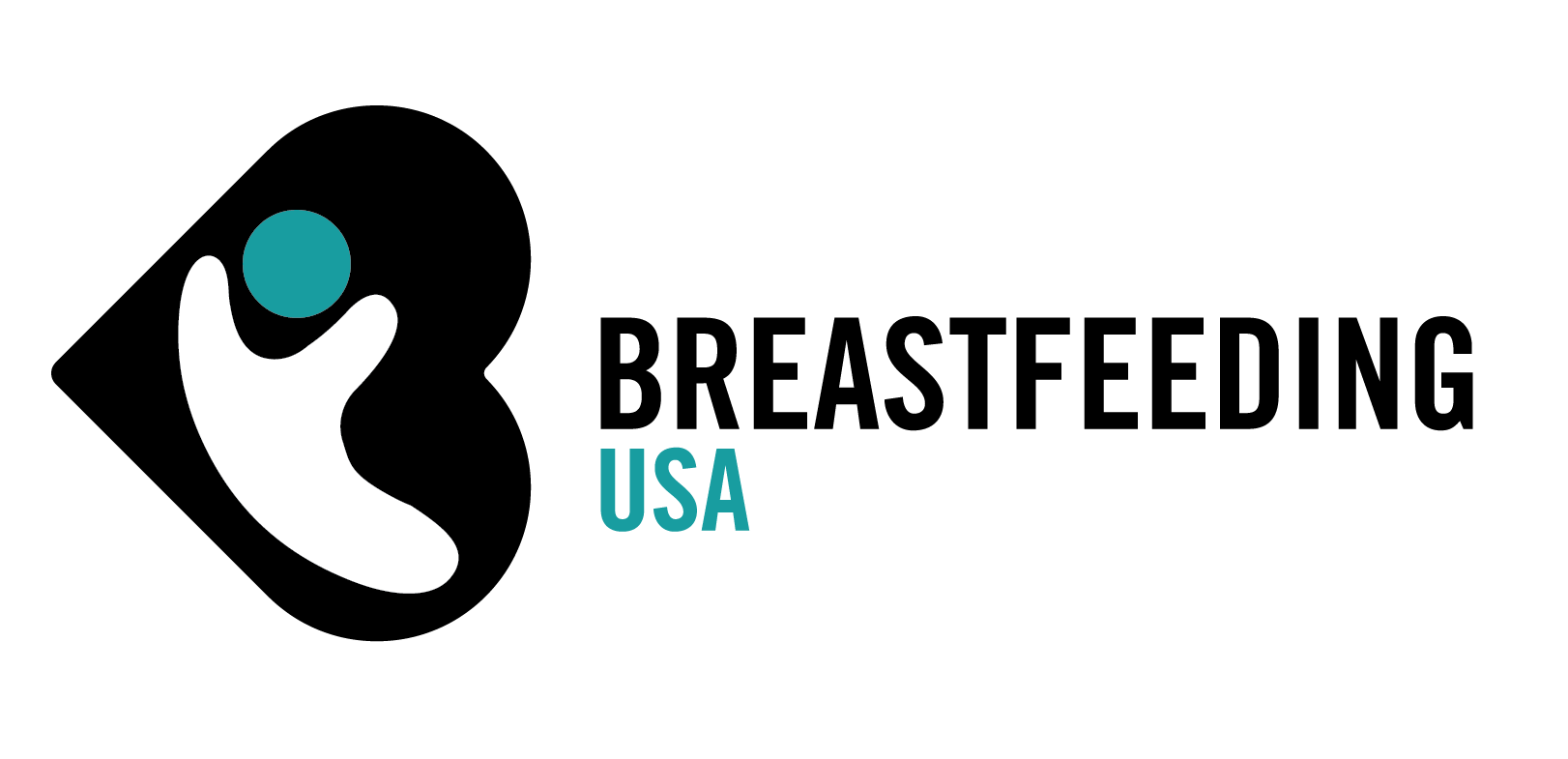
By Mia Gonzalez
There it is: one beautiful beating heart on the ultrasound screen… and then you see another. Whether you knew it was a possibility or not, the moment you discover you’re having more than one baby is life-changing.
Preparing for the birth of your babies:
While it is true that twin pregnancies are more likely to have complications (though only slightly higher than singletons when twins have their own amniotic sac and placenta) and are statistically more likely to end in cesarean section, having twins does not mean you can’t exclusively breastfeed or have a fulfilling breastfeeding experience.
Breastfeeding is the way human babies were made to be fed, regardless of whether they shared the womb with a sibling or not. Twins, statistically, are born earlier than singletons, and premature babies are even more in need of the healing power of their mothers milk. Especially if this will be your first time breastfeeding, it is very important to find evidence-based sources of information right away. Well-meaning medical professionals, friends, and family can set “booby traps” that can prevent you from reaching your breastfeeding goals.
Get mentally prepared:
Know that for the first few weeks of their lives, feeding your babies and sleeping should be your top priorities. Plan to do nothing but feed and love your babies, so when you do get an hour of freedom to go take a shower or close your eyes for a moment, you’ll feel refreshed instead of stressed that you only have an hour. The first few weeks can be exhausting, so keep reminding yourself that babies change quickly–it will not be like this forever. Perspective makes a big difference in times like these.
Build a strong support network and seek out information:
Physician support and knowledge about breastfeeding can differ greatly, so dialogue with your provider and get a feeling for the level of support that you will receive. Ideally, you can find a really knowledgeable health care provider before your babies are born. You may need to seek out other sources of help in your community. In our culture, bottles are the default way to feed a baby (even if they contain human milk instead of formula), and it can be difficult to sort through the information available. It is imperative that you have breastfeeding-knowledgeable people in your corner ready to lend you a hand if things don’t go perfectly.
Find a local Breastfeeding USA chapter and attend meetings before the birth of your babies. Seeing other mothers breastfeed and hearing their real-life stories are two of the most important things you can do to prepare for breastfeeding. If there is no Breastfeeding USA group in your area, find another local breastfeeding group. Make sure to include your partner and support people in your learning, so they won’t unknowingly undermine your efforts. Visit credible websites like Kellymom.com, or Dr. Jack Newman’s site, and remember that the people in forums and chat groups share personal experiences and opinions which may not be evidence-based. Take a breastfeeding class with your partner and know who to call in case you need help (Breastfeeding USA Counselor or IBCLC).
Making enough milk:
Regardless of the number of babies you are breastfeeding, establish and maintain good milk production by watching your baby and responding to your baby’s hunger cues. Let the baby determine the length of feedings. Feeding as soon as you can post birth is important for establishing a good latch and good production. Learn more about baby-led latch here.
Your breasts will respond and make as much milk as needed, based on the amount of milk that the babies remove. Your baby will let you know if s/he is getting enough with the usual clues: frequent breastfeeds (at least 8-12 times in 24 hours), many wet and soiled diapers, steady weight gain. Newborns feed often; this is normal and how your body establishes milk production. If you are concerned about the frequency of feedings, especially when one baby seems to be breastfeeding a lot more often and/or longer than the other, it’s a good idea to get some help. Here is some more information about frequent feedings.
So many messages tell mothers of twins that they cannot make enough milk for two babies at once. It is assumed by many medical professionals that twins will have to be supplemented, but in fact the opposite is true. Most mothers of twins can make more than enough milk for their babies. Trust that your body was built to do this; confidence and successful breastfeeding go hand in hand. Surround yourself with positive messages. Join groups online full of positive people with positive stories to share. Read positive books, ones that tell you how to breastfeed twins, not just how to manage bottle-feeding twins. A great book is Mothering Multiples: Breastfeeding & Caring for Twins or More by Karen Kerkhoff Gromada. Know that your babies are no different because they came together; they are just two babies who need their mother’s milk, and your body was made to provide it.
What if one or both of my babies is in the NICU?
Some babies who stay in the NICU are not strong enough or coordinated enough to breastfeed. This does not mean that mothers cannot provide their babies with breast milk. The number one priority in this situation is to establish and maintain your milk production, pumping every 2-3 hours around the clock with a high quality electric breast pump. Hospital grade pumps are available for free or rent at some hospitals. Ask for help from an International Board Certified Lactation Consultant (IBCLC) at the hospital, if one is available, and contact a Breastfeeding USA Counselor for further support. Your babies can receive your milk via a supplemental feeding device used while breastfeeding, finger feeding, syringe, spoon, cup, or bottle. Discuss feeding options with your baby’s care team. Even if one or both of your babies don’t start out breastfeeding, with the proper support you can get them back to the breast when they are bigger and stronger.
Meeting the needs of each baby:
Feeding twins on cue can be very different from feeding a singleton on cue. It’s possible that your babies will start showing hunger cues around the same time for most feedings. If they do–great! Some twins, especially fraternal twins, have different temperaments and different needs. One twin may need to eat every two hours, while the other is content with every three or even four! You may hear that you have to keep them on the same schedule, but there are different ways to handle babies who seem to have naturally different rhythms.
You can
- feed both babies when the first one gets hungry.
- allow both babies to follow their own patterns and feed them individually.
- use a combination of both methods.
Some mothers find that they can follow individual cues throughout the day but need to keep both babies on the same feeding rhythm at night to minimize night wakings. Get creative! Whatever you decide to do, remember that you can try something new at any time. Your babies will be growing and changing quickly in the first few months; nothing will stay the same for long.
Tandem or individual feeding? How to juggle breastfeeding twins:
Breastfeeding two babies feels like a juggling act, but with a little practice, creativity, and planning, it can be done with ease.
In the early days and weeks of breastfeeding, both you and your babies are learning to breastfeed. Even if your twins are not your first breastfed babies, having twins often feels like being a new mom all over again. Breastfeeding two babies simultaneously is a wonderful skill to learn. It saves so much time if you can nurse your babies together instead of one after another. But like any skill, it takes practice. If one of your babies is struggling to achieve a good latch, it’s okay to breastfeed them by themselves until you both become more skilled. Get creative with breastfeeding positions, and try them more than once or twice.
Babies change a lot during their first few weeks and months. When you have more than one baby reaching the milestones, it can seem much more intense, especially the relief when things suddenly get a lot easier! Babies naturally become more efficient at breastfeeding as they get older, spending less time at the breast and eventually nursing less frequently. Positions that were impossible to imagine using when your babies were 2 weeks old suddenly are your favorite positions when they are 6 months old.
Two vs. one, is it that big of a difference?
It’s hard to explain to people who have never had the experience of caring for two babies simultaneously what it is like and how it is different from caring for just one. I had a single baby, then twins, then a single baby again, and I can confidently say that breastfeeding my twins in the first few weeks was both the hardest and one of the most empowering things I’ve ever done as a parent.
Having people around who believed that breastfeeding twins was normal and possible was the only way I made it over the hurdles I encountered in the first few months. By the time my twins were six months old and we had really gotten the hang of things, I was so incredibly thankful that I didn’t have the extra work of preparing and cleaning bottles of formula, or pumping, then preparing, and cleaning bottles of breast milk. I was so glad that I had help and persevered through the first weeks when feeding twins. It is a huge job no matter how you choose to do it! Get informed; get help; and you, too, can breastfeed your babies!
Further reading:
Kellymom.com: Breastfeeding Multiples (Resources)
March of Dimes: Feeding your baby in the NICU
To Pump More Milk, Use Hands-on Pumping
Baby-Led Latch: How to awaken your baby’s breastfeeding instincts
Some Ins and Outs of Laid-Back Breastfeeding
Diaper Output and Milk Intake in the Early Weeks
Mia Gonzalez
Mia lives in Connecticut with her four children. She is the mother of two singletons and one set of twins. She breastfed her one-year-old twins through her last pregnancy and then tandem-nursed the twins and her youngest child for over a year.
© Copyright Breastfeeding USA 2015. All rights are reserved.
